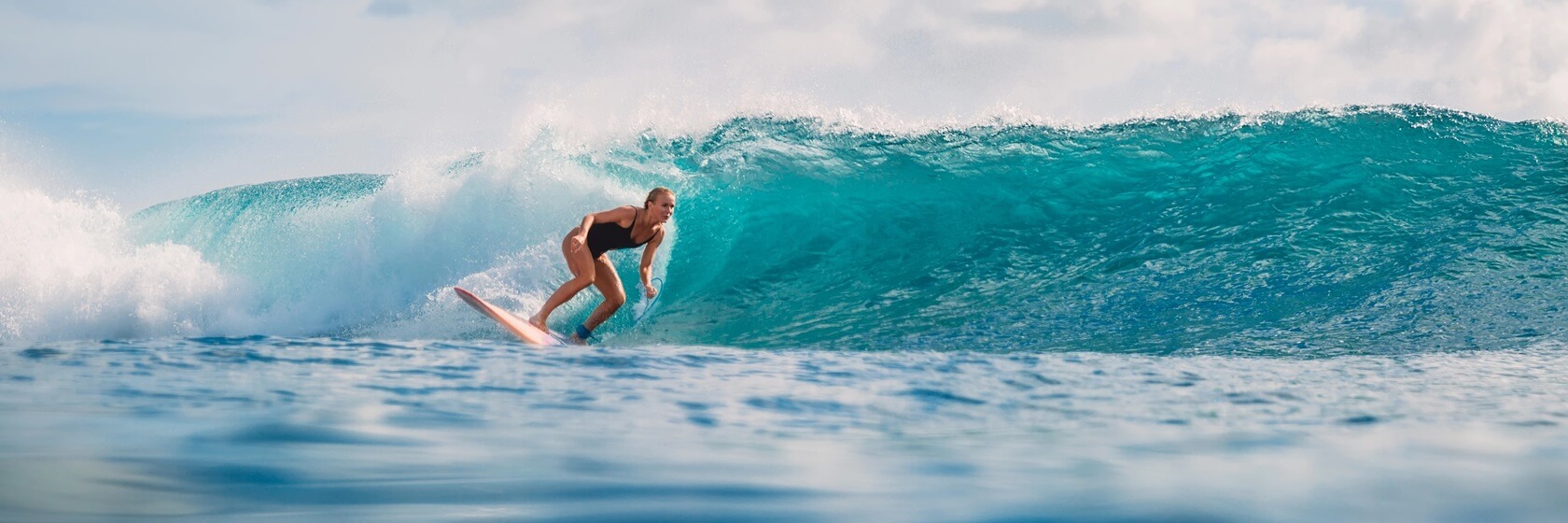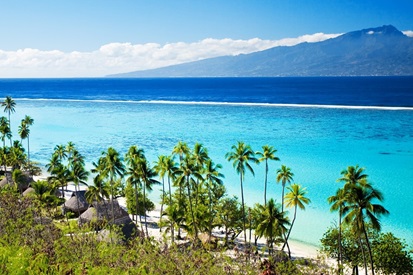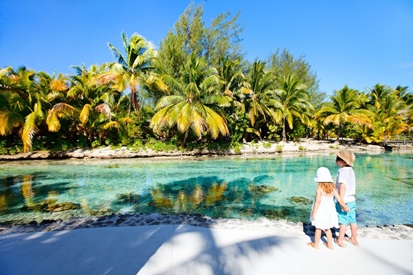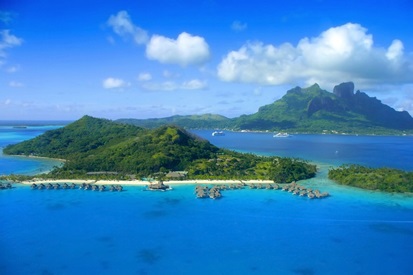

Tahiti and French Polynesia in general are a surfing paradise. You can find waves on these magnificent islands all year round. Teahupo'o in Tahiti is a legendary place where world-class competitions take place every year. This is where one of the biggest and most dangerous waves on the planet is caught!
Stretching over approximately 3.5 thousand square kilometers of the Pacific Ocean, the island of Tahiti is the largest and most visited of the Polynesian islands. The capital Papeete and the main international airport are located here. All surfers flock to the most famous location, Teahupo'o, where one of the most interesting waves in surfing rises. However, surfing in Tahiti isn't all about Teahupo'o. There are many other spots on the island for advanced surfers.

Depositphotos
Surf spots in Tahiti
In Tahiti, in addition to the most popular surfing location, there are countless other locations that are generally little known. Surfing on the southern section is more suitable during the main southwest swell season (May to October). On the northern shores, along a series of black sand coves, there are curved bowl-shaped areas for beginners. In the south there are all kinds of reefs where you will find a wave of any difficulty, south direction, with right and left direction and added barrels. Overall, the surf in Tahiti is excellent for professionals and absolutely fantastic for intermediates. And besides the waves, you get to know pristine coral reefs, simply teeming with life.

Depositphotos
Teahupo'o
Teahupo'o (pronounced and sometimes called cho-poo) is the wave everyone is talking about. It is thanks to this wave that French Polynesia has been in the spotlight for the last 20 years and the islands host the Billabong Pro and WCT tournaments. This is no place for amateurs: only a master can conquer the waves and stay alive. Teahupo'o has claimed more than one life and broken more bones and surfboards than anyone can count.
Teahupo'o Peak is located just at the western end of the long slope of coral reef that runs along the southwestern side of the island of Tahiti.
Teahupo'o breaks on a very shallow and very sharp reef, making everyone pay for their mistakes. This location should be reserved for advanced surfers.
The boats travel through a wide channel that opens to the west of the main point and then drop off surfers at the take-off area. It is the shape and nature of the coral shelf itself that gives it its special value. When strong southerly waves hit the outer reef, they reach less than half a foot between the ocean surface and the corals. This pushes a huge amount of water upward, turning the wave into a very thick and flat barrel in a matter of seconds.
Takeoff occurs directly into a super-hollow surface that is almost perfectly tubular. If you can get the angle right or put it together with a good bottom turn, then you can hit the middle section and ride the best wave of your life. This only lasts a few seconds before you are thrown left into an area that is usually littered with jet skis and cameramen.
- Wave direction: Left
- Bottom: Reef
- Best tide: Medium
- Skill Level: Advanced
- Optimal swell direction: SW
- Optimal wind direction: East

Depositphotos
Taapuna
Travel south from Papeete. Here is a famous surf break - one of the most spectacular surf spots in Tahiti.This is a classic Tahitian reef with a dangerous reef that is suitable for intermediate surfers and above.
- Wave direction: Left
- Bottom: Reef
- Skill Level: Advanced
- Optimal swell direction: SW
- Optimal wind direction: East

Depositphotos
Papeno'o
Papeno'o is in some ways the polar opposite of Teahupo'o. This is a north coast wave located on a black sand beach about 25 minutes west of the capital Papeete.Papeno'o has a beach surf break and river mouth.
Both offer good waves, especially during the north swell season from November to April. Beginners are better off staying on the beach as the river mouth is a bit stronger and prone to rip currents.
It can be divided into two breaks: the outer mouth and the inner bank. The first one is more suitable for advanced surfers. During the rainy season, easterly and northeasterly waves arrive.
The inner beach break is usually a little smaller and shaped like an A-shaped peak with good runs for confident beginners and up.
- Wave direction: Left and right
- Bottom: Sand and pebbles
- Best tide: Any
- Skill Level: Beginner to Advanced
- Optimal wave direction: North
- Optimal wind direction: South

Depositphotos
Papara
Papara is not far from the shelf reefs that gave the world Teahupo'o, but it is a completely different type of holiday. Known as the playground for beginner surfers in Tahiti. During the peak season (May-October) there are more surfers and the place is expected. In November - April the location is available for all levels, with right and left waves.

Depositphotos
Vallée de la Papenoo
The waves here are the perfect size, making it a popular spot for beginners. After several attempts, you manage to stand up for a few moments. Be careful, it is still not as safe as other islands in the world.

Depositphotos
When to surf in Tahiti
The main surfing season in Tahiti is during the dry months from May to October. It's officially winter in French Polynesia, but in reality it's the time of year with the best weather and best waves. The South and South West channels operate at 80% consistency in May and 99% in June, when almost every day brings interesting waves to the reefs from Papara to Teahupo'o.
The swells in the southwest and south are stronger during the winter months, providing the best surf breaks. The water in Tahiti is clear and always warm, never falling below 25C.
Overall, the best time to surf in Tahiti depends on what conditions you're looking for. If you are looking for adrenaline and are confident in your abilities, then the best season is winter (from May to September), then you are guaranteed big waves. During the winter months, large southwesterly swells arrive and cover all the reefs on the south side of the island, including Teahupo'o. Then the weather is cool and dry. This is also a dry season with lower humidity and moderate temperatures, ranging from 21 to 27 degrees. The water temperature ranges from +23 to +26 degrees all year round. No matter when you visit, winter or summer, you will never need wetsuits. But reef shoes can be very useful…
The summer months from November to April promise good northerly swells with smaller but consistent southerly swells. These months will be quite rainy and hot.
Don't be put off by the prospect of traveling during the summer months from November to March. The 180 degree shift in the direction of the swell results in many steep swells to the north. They feed estuaries and sandbars on the north side of the island with plenty of surf to ride on, usually in the 1-2.5 meter range.

Depositphotos
Tips for surfers
- Rule No.1, which will allow you to discover interesting locations, is to spend time with local residents, get to know the “bosses” of the area. This is the only way to understand surfing in Polynesia. Many surfers come to Tahiti, but you can’t keep 100 people on the water at the same time: otherwise the rescuers won’t be able to keep track of them. If you make the effort to integrate into the Tahitian culture, they will pick you up and take you to your destination. And once you pass this stage, you can live the real story on this island.
- If you're a beginner or haven't tried surfing yet, take surfing lessons. For these surfers, this is the perfect island to learn from.
- Most of the surf spots on the south side, including Teahupo'o, are broken by sharp, shallow coral reefs. Take a first aid kit with you.
- Don't go on waves that aren't suited to your level. Because in Tahiti more often than anywhere else, a mistake can be fatal. Teahupo'o is of course the most famous wave on the island, but it is also one of the most dangerous in the world.
- For those who aren't ready to taunt one of the most famous walls of water on the planet, just visiting the area is almost a pilgrimage. You can just go to this location, you don’t have to surf there, risking your life. Teahupo'o is primarily a small wild village located at the end of the road in Tahiti. It is often called the end of the world. Near the square at the end of the road there is a sculpture in the shape of a wave, it is located next to a large wooden surfboard stuck in the ground. At the foot you can see the inscription PK0, zero kilometer. An emblematic place that gives all surfers goosebumps without even entering the water.

Depositphotos
What you need to know when going surfing in Tahiti
- Whale watching season is from June to November. You can use this opportunity.
- Shark sightings are common, but usually blacktip sharks.
- The time difference with Europe is 11-12 hours in the summer.
- Temperature: from + 25 to + 27 degrees all year round.
- Water temperature: from +23 to +26 degrees all year round.
- Dry season: May to October.
- Language: Tahiti is part of French Polynesia, an overseas territory of France. French is the only official language of French Polynesia, but the vast majority of the population also speaks Tahitian.
- Currency: Pacific franc (1 € = 120 francs).

Depositphotos
How to get to Papeete?
Until 2018, only 2 airlines offered flights to Papeete: Air Tahiti Nui and French Bee. United Airlines recently began offering flights from San Francisco, and Hawaiian Airlines flies from Honolulu, making it more accessible for travelers.

Depositphotos
Don't miss the opportunity to see the most terrifying wave on the planet!
More articles
- Top 20 Bali Tours: Itineraries, Offers, and Prices
- Bali's Best Beach Clubs - 13 Luxury Oases
- Tips for tourists in Indonesia - how to avoid spoiled holidays
- Yoga Studios in Bali - where to catch Zen on the Island of the Gods
- Port Louis: All About Mauritius' Capital
- Seychelles Honeymoon Hotels: 9 Paradise Spots
- Bali's Best Eco-Hotels: Top 12 Spots
- Seychelles for outdoor activities - from diving to jungle trekking
- Why you can be deported from Bali - several main reasons
- Seychelles hotels with the best panoramic views



